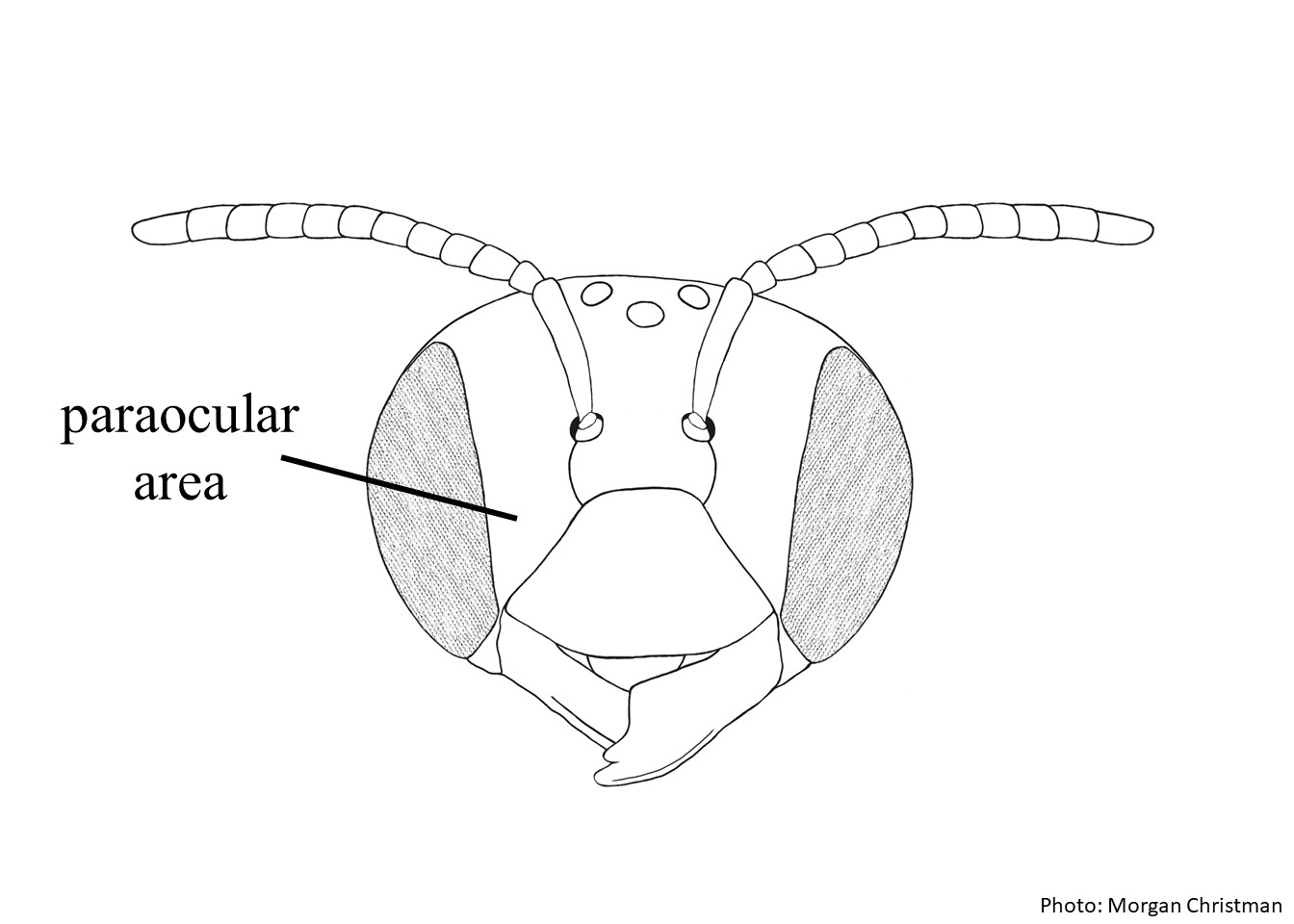Family: Apidae
Subfamily: Xylocopinae
Tribe: Ceratinini
Genus: Ceratina Latreille, 1802
Subgenus: Neoclavicera Roig Alsina, 2013
Common name: small carpenter bees
Ceratina (Neoclavicera) are small to medium-sized bees that usually have dark integumentintegument:
a tough, protective outer layer
with olive, blue, or purple metallic reflections, which are sometimes restricted to the abdomen. They often have yellow markings on their clypeusclypeus:
a section of the face below the antennae, demarcated by the epistomal sutures and paraocularparaocular:
the area extending along the sides of the face parallel to the eye
 areas and sometimes on their pronotal lobes and legs. Females range in body length from 6.0–9.3 mm; males range from 5.4–7.5 mm. (Roig Alsina 2013Roig Alsina 2013:
areas and sometimes on their pronotal lobes and legs. Females range in body length from 6.0–9.3 mm; males range from 5.4–7.5 mm. (Roig Alsina 2013Roig Alsina 2013:
Roig Alsina, A. 2013. El geacute;nero Ceratina en la Argentina: revisioacute;n del subgeacute;nero Neoclavicera subg. n. (Hymenoptera, Apidae, Xylocopinae). Revista del Museo Argentino de Ciencias Naturales 15 (1): 121ndash;143.).
(modified from Roig Alsina 2013Roig Alsina 2013:
Roig Alsina, A. 2013. El geacute;nero Ceratina en la Argentina: revisioacute;n del subgeacute;nero Neoclavicera subg. n. (Hymenoptera, Apidae, Xylocopinae). Revista del Museo Argentino de Ciencias Naturales 15 (1): 121ndash;143.)
 area densely punctatepunctate:
area densely punctatepunctate: but not S3S3:
but not S3S3: .
.Ceratina (Neoclavicera) are similar to the species in Ceratina (Crewella) and Ceratina (Calloceratina) by having a complete carinacarina:
a clearly defined ridge or keel, not necessarily high or acute; usually appears on bees as simply a raised line
along dorsumdorsum:
in general, the upper surface
of pronotumpronotum:
a collar-like segment on the thorax and directly behind the head; extends down the sides of the thorax toward the first pair of legs which extends laterally and a well-developed preoccipital carinacarina:
a clearly defined ridge or keel, not necessarily high or acute; usually appears on bees as simply a raised line
. Ceratina (Neoclavicera) can be separated from the other subgenera by the single apicalapical:
near or at the apex or end of any structure
tooth on the front and mid tibiaetibiae:
the segment of the leg, between the femur and the tarsus, and by the wax plate restricted to the S2S2:
the plates on the underside of the abdomen, often abbreviated when referring to a specific segment to S1, S2, S3, S4, S5, S6, S7, or S8
 in females.
in females.
Ceratina asunciana has been observed visiting flowers of Senecio grisebachii (Asteraceae); C. subcarinata visits flowers of Leonurus sibiricus (Lamiaceae), Arctium minus (Asteraceae), and Eupatorium (Asteraceae); Ceratina caveata visits flowers of Senecio sp. (Asteraceae) (Roig Alsina 2013Roig Alsina 2013:
Roig Alsina, A. 2013. El geacute;nero Ceratina en la Argentina: revisioacute;n del subgeacute;nero Neoclavicera subg. n. (Hymenoptera, Apidae, Xylocopinae). Revista del Museo Argentino de Ciencias Naturales 15 (1): 121ndash;143.).
Nesting behavior is unknown, but it is expected that Ceratina (Neoclavicera) nest in pithy stems and twigs, as do most species of the genus Ceratina.
Ceratina (Neoclavicera) includes eleven species (Roig Alsina 2013Roig Alsina 2013:
Roig Alsina, A. 2013. El geacute;nero Ceratina en la Argentina: revisioacute;n del subgeacute;nero Neoclavicera subg. n. (Hymenoptera, Apidae, Xylocopinae). Revista del Museo Argentino de Ciencias Naturales 15 (1): 121ndash;143.).
There are no known invasives.
Ceratina (Neoclavicera) is known only from South America where they are found from Peru and Brazil, south to Argentina and Uruguay (Roig Alsina 2013Roig Alsina 2013:
Roig Alsina, A. 2013. El geacute;nero Ceratina en la Argentina: revisioacute;n del subgeacute;nero Neoclavicera subg. n. (Hymenoptera, Apidae, Xylocopinae). Revista del Museo Argentino de Ciencias Naturales 15 (1): 121ndash;143.)

Distribution map generated by Discover Life -- click on map for details, credits, and terms of use.
Roig Alsina, A. 2013. El género Ceratina en la Argentina: revisión del subgénero Neoclavicera subg. n. (Hymenoptera, Apidae, Xylocopinae). Revista del Museo Argentino de Ciencias Naturales 15 (1): 121–143.